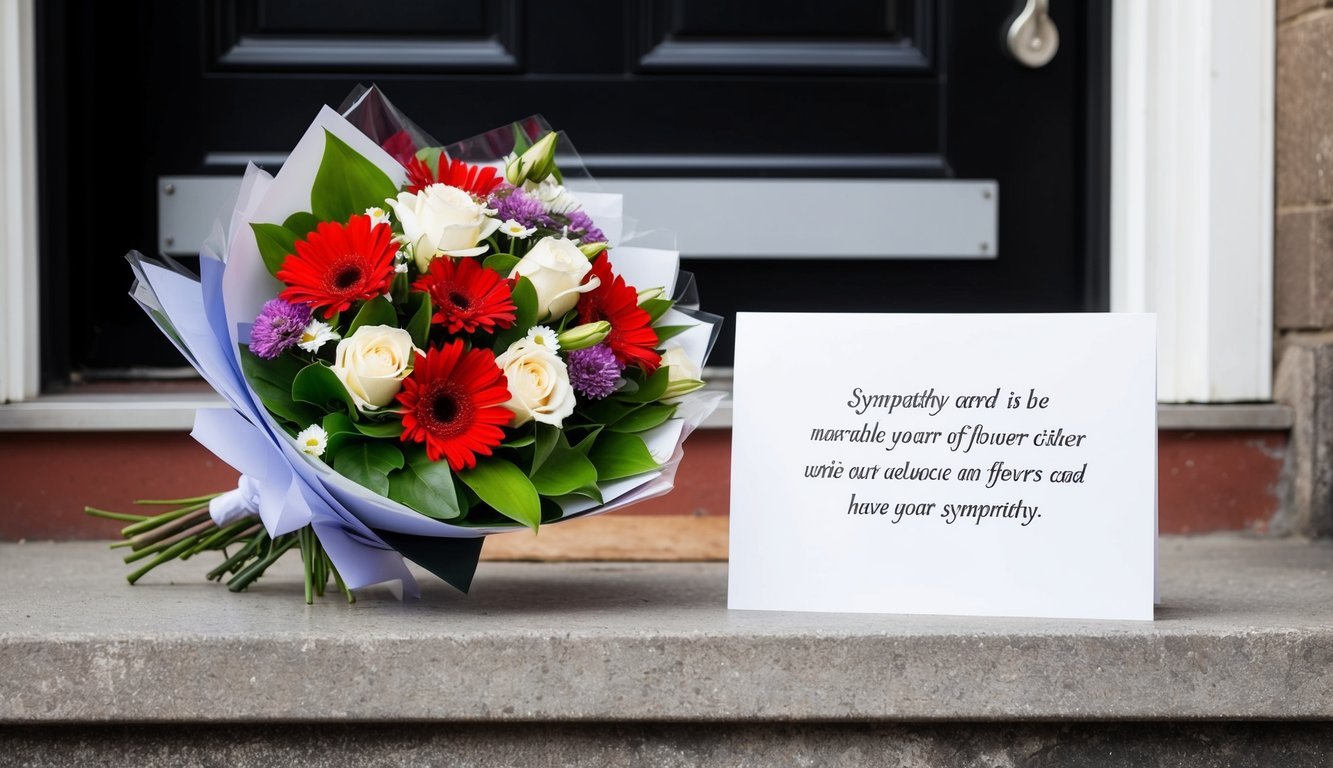PsychNewsDaily Publishers
100 Summit Drive
Burlington, MA, 01803
Telephone: (320) 349-2484
PsychNewsDaily Publishers
100 Summit Drive
Burlington, MA, 01803
Telephone: (320) 349-2484
Condolences provide essential comfort to the grieving, emphasizing empathy and support. Effective messages involve personal memories, expressions of sympathy, and ongoing emotional assistance during difficult times.

Condolences play a crucial role in offering comfort to those who are grieving. They reflect the complexity of emotions involved in loss, as well as the support that friends and family can provide. Understanding the nuances between empathy and sympathy can help in expressing condolences effectively.
Grief is a natural response to loss. It can bring a mix of emotions, such as sadness, anger, and confusion. Each individual experiences grief differently, making it important to recognize that there is no “right” way to feel.
Grieving can also impact mental and physical health. Some people may withdraw, while others seek out support. Understanding these responses can help friends and family provide appropriate support.
Those offering condolences need to listen and be present. Simple gestures, like sending a card or offering a hug, can mean a lot to someone in pain. It’s this understanding that strengthens connections and fosters healing.
Empathy and sympathy are often confused, yet they carry different meanings. Empathy involves putting oneself in another’s shoes, feeling their pain, and truly understanding their experience. This can create a strong bond and provide real comfort.
On the other hand, sympathy reflects care and concern without necessarily sharing the feelings of the other person. While both are important, empathy often resonates more with those who are grieving.
Offering empathetic condolences can involve acknowledging feelings directly, such as saying, “I can’t imagine how hard this must be for you.” This validates the grieving person’s emotions and shows a level of understanding that can be incredibly comforting.

Writing a condolence message can be challenging, but it’s important to express sympathy thoughtfully. A well-crafted message can provide comfort to those who are grieving. This section explores how to structure these messages, common phrases to include, and ways to personalize the sentiment.
A condolence message should have a clear structure. Start with a greeting, followed by an expression of sympathy.
This clear structure helps convey heartfelt condolences while also providing support.
Using common phrases can help convey feelings appropriately. Here are some examples:
Including condolence quotes can also add depth. For instance, “To live in hearts we leave behind is not to die” can resonate with those grieving.
These phrases are not only respectful but can also bring a sense of shared understanding and comfort.
Personalizing a condolence message makes it special.
Tailoring messages in these ways shows thoughtful consideration and care.

Supporting someone who is grieving is vital. It involves being there for them emotionally and providing practical help. Each act of support can make a significant difference during a difficult time.
Being present means simply showing up for the person who is hurting. This can be as simple as sitting quietly with them. Grief can be overwhelming, and having someone nearby provides comfort.
Listening is also a key part of being present. They may need to talk about their feelings, share memories, or express sadness. Encouraging them to share can help them process their grief.
Words of comfort can be helpful too. Simple phrases like “I’m here for you” or “You’re not alone” can provide reassurance. Most importantly, showing empathy by validating their feelings is crucial. It allows them to feel understood and cared for during this tough time.
Practical help can relieve some of the burden a grieving person feels. This type of support can include specific tasks or errands that may seem overwhelming right now.
Offering to cook meals, help with household chores, or run errands can be a great start. Even small gestures, like bringing groceries or taking care of pets, can ease their load.
Additionally, offering help with paperwork, like funeral arrangements or insurance claims, can significantly lessen their stress. Grieving can leave individuals feeling exhausted, so any practical assistance can be invaluable.
It is important to ask what they need rather than assume. Each person has unique needs during their grief, and tailoring help to the individual can enhance the support they receive.

Sharing memories can bring comfort during difficult times. It allows people to reflect on happy moments and keeps the spirit of the loved one alive. Fond memories can provide a sense of peace, helping those who are grieving to feel connected despite their loss.
When someone shares a memory, it can spark warmth and connection. Choosing a comforting memory can light up a room. This could be a funny story or a simple moment that shows the person’s kindness.
For example, recalling a favorite childhood game or a shared family tradition can evoke smiles. These memories often remind everyone how much love was shared.
It’s helpful to focus on stories that highlight positive traits. Sharing these fond memories can create a supportive atmosphere. It shows that the loved one will always be remembered for the joy they brought to others.

When someone experiences a loss, how they express condolences can vary based on their relationship with the bereaved. Different contexts such as family members and friends or professional acquaintances shape the way people communicate their sympathy. Understanding these differences can guide one in offering support during difficult times.
Condolences from family members often carry deeper emotional weight. They may express personal memories or shared experiences that emphasize their bond with the deceased. For example, a brother may say, “I will always remember our family camping trips.”
Friends, while still sincere, might focus more on comfort. They could say, “I’m here for you. Let’s talk when you’re ready.” Friends often aim to provide emotional support without diving into intimate memories unless the grieving person leads that conversation.
Both types of condolences should be heartfelt. Simple gestures like bringing a meal or sending a card can also mean a lot. It shows thoughtfulness and care.
When expressing condolences in a professional setting, it’s essential to maintain respect and formality. A colleague might say, “I was saddened to hear about your loss. Please let me know if you need anything.” This keeps the tone appropriate while still showing compassion.
In the workplace, sending a sympathy card or flowers is a common practice. It provides a thoughtful gesture without crossing personal boundaries.
For professional acquaintances, the focus remains on offering support without going into personal details. The goal is to acknowledge the loss and extend help, letting the recipient decide how much to share about their feelings.

Continuing support for those who are grieving is essential. It offers comfort and shows that love and friendship remain strong, even in times of sorrow. Regular check-ins and recognizing important dates can help the grieving feel less isolated.
Making an effort to check in with someone who is grieving can be incredibly meaningful. Simple messages or calls can provide comfort. They remind the person that they are not alone in their sorrow.
People can express their care through daily prayers or notes. Saying, “I am thinking of you” can have a positive impact. Friends should not hesitate to offer their love or say they are available for support.
It’s important to follow up on previous conversations. Asking how they are doing can show genuine interest. Even sharing a favorite memory about the lost loved one can bring warmth.
Anniversaries and special dates can be particularly hard for someone who is grieving. These moments often bring back strong feelings of loss. Acknowledging these important days can provide the grieving person with a sense of support.
Sending a thoughtful card or text message can show that they are remembered. Offering to spend time together during these tough periods can also be beneficial. It allows the grieving person to share their feelings.
Friends can also suggest activities that honor the loved one. This can include visiting a favorite place or participating in a meaningful event. Such gestures can foster love and connection during a time of sorrow.

When someone faces a loss, expressing condolences can help provide comfort. Here are some specific ways to convey sympathy and support.
Choosing kind words that reflect your feelings is important. A simple message such as “I am so sorry for your loss” can mean a lot. Personalizing the card with a memory of the deceased can also add a special touch.
Text messages should be short and heartfelt. Options like “Thinking of you during this difficult time” or “I’m here for you if you need anything” can provide warmth and support. It’s key to let the person know they are in your thoughts.
Brief messages can be impactful. Suggestions include “My heart goes out to you,” or “Wishing you peace and comfort.” Even a simple “I care about you” can show that you are there for them.
Messages should reflect sincerity. Phrases like “Please accept my deepest condolences” or “I cannot imagine your pain, but I am here for you” can offer comfort. Acknowledge their grief and let them know they are not alone.
Offering condolences sincerely involves expressing true empathy. Saying something like “I am heartbroken for you and your family” communicates deep sympathy. It’s important to resonate with their feelings and show understanding.
Comforting words should be gentle and supportive. Saying “I am here to listen whenever you need” or “Take all the time you need to heal” shows compassion.
Being present and offering support can mean a lot during such a tough time.